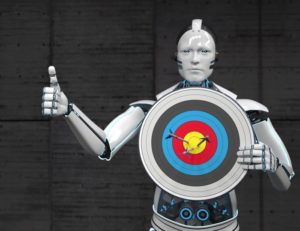
20 AI Predictions for 2020

(sun-ok/Shutterstock)
It doesn’t take a soothsayer to know that artificial intelligence will have a bomber 2020. But getting the details right is important, which is why we turned to industry experts to give us their predictions on exactly how AI will evolve next year.
There is widespread fear that AI will replace human workers. But 2020 will be the year when we stop fearing the tech and start realizing how it benefits us, predicts Tim Armandpour, the SVP of Engineering at PagerDuty.
“In their next phase, AI and ML will become our allies (not our replacements),” Armandpour says. “The next few years will be about finding the sweet spot where you put human power and human thinking first, then add just the right amount of AI and ML to make things more efficient. Rather than automating operations out of the way, AI and ML can be an ally; something teams can lean on to help cut down on inefficiencies.”
As big data morphed into AI, the tools got better and more self-serviceable. That trend will continue in 2020 as the industry shows immense interest and adoption of “no-code analytics,” says Chad Meley, vice president of marketing at Teradata.
“We’ve seen a steady democratization of advanced analytics by automating away certain laborious aspects such as feature engineering and model selection,” Meley says. “But advanced analytics become truly pervasive when machine learning and other advanced procedural analytics becomes something that requires absolutely no coding or SQL skills. No-code analytics become embedded in workflows or invoked through simple drop down menus. They won’t make coding obsolete in the analytics world, but will increase the number of use cases benefitting from analytics in large enterprises by a factor of one hundred.”
Effective implementation of AI and ML has been a challenge in 2019, and it will continue to be a challenge in 2020. To differentiate themselves, organizations need to move beyond the algorithm, says Per Nyberg, chief commercial officer of Stradigi AI.
“Business leaders have moved past needing to be convinced of the importance and necessity of AI. They are now coming to grips with the implications on their businesses – from data and technology platforms to skills and culture,” Nyberg says. “Along the same lines, businesses are moving past discussing the weeds of machine learning algorithms. Now, companies have shifted their energy to AI deployment and scale across the organization. These shifts also impact the talent pool. Companies can’t just rely on researchers to move the needle for AI. New roles will be created and traditional roles will adapt with every step in a company’s AI journey.”
2020 is the year that ML becomes truly foundational across industries, says Hugo Bowne-Anderson, Data Scientist, host of the DataFramed podcast.
“ML will continue to fundamentally shift the nature of business, society, and our lives,” Bowne-Anderson says. “More importantly, it will shift from being a disruptive technology to being foundational across a wide range of established vertical industries including technology, healthcare, finance, retail and many more.”
Expect machine learning deployments to make growth in 2020, but the calendar will read 2021 before it goes mainstream, Pepperdata CEO Ash Munshi says.
“AI is still in the purview of large enterprises but it will start to become mainstream in the latter half of 2020 where it will go beyond its use in social media and recommendation engines,” he says. “Practical machine learning is still further way—we will be looking for where it will be integrated into day to day processes: like making smart meters truly smart or integrated into how we are treated for a life-threatening illness. Core industries need to adapt to it before it becomes mainstream and that will begin to happen sometime in 2021.”
AI and ML have made some real progress in some industries, but better standards are needed for it to really blossom, says Saurav Chakravorty, the principal data scientist at Brillio.
“To sustain the scale that AI/ML has already attained in many industries, there is an acute need to formalize the development and delivery process of ML code and models,” Chakravorty says. “MLOps will emerge as a key process that empowers data scientists and app developers to help bring ML models to production by enabling tracking, versioning, auditing and reproducing each element of the ML lifecycle.
AI is a powerful technology, but it carries the potential for abuse. That’s why Richard Socher, the chief scientist of Salesforce’s Einstein initiative, says the industry will start to come to grips with that reality.
“The field of AI will come to terms with its age and success,” Socher says. “Questions around the ethics of AI are not new, but 2020 will be the year of reckoning as the industry builds out the best practices and regulations required for ensuring that AI works in the best interest of people.”
In the early days of practical AI, organizations were focused on getting results. But in 2020, the way companies are getting results with AI will come under intense legal scrutiny, predicts Saif Ahmed, the product owner of machine learning at Kinetica.
“For a long time, the focus was on accuracy and performance,” Ahmed says. “But this year we’re starting to see companies focus on things such as regulation, auditability, fairness, etc. I predict 2020 will be the year of governance because we can’t afford for it not to be. Documentation and transparency will get top priority in 2020, as we take a step back to make sure our results follow a consistent governance framework.”
AI is making its way into all sorts of products and services these days as companies compete to win customers. As the AI arms-race continues, keeping up with the Joneses will require increased vigilance, says Tatianna Flores, the head of the AI Lab at Atos North America.
“2019 revealed that highly specialized applications of AI geared toward industry-specific problems are hot commodities. Tesla acquired a company that focuses exclusively on object recognition, and McDonalds acquired a speech recognition company focused on languages,” she says. “In the coming year we’ll see even greater competition to improve performance in these popular and specialized applications of AI. Products will need to integrate reinforcement learning to constantly improve deep learning applications and stay ahead of their competition.”
Four out of five employees around the world don’t have a desk, but only 1% of the world’s software targets deskless environments, according to Srivatsan Laxman, the CEO of FrontdeskAI. 2020 will see that dynamic start to change.
“Technology tools, such as conversational AI assistants, that create consistency, connect the dots, and help provide centralized intelligence, and analysis will be key,” Laxman says. “…[C]onversational AI assistants will play a critical role in capturing the intelligence of customer engagement patterns and maintaining consistency – thus operational efficiency – in front desk processes.
AI is making more and more decisions on our behalf, across all walks of life. How we deal with the negative consequences of those AI-based decisions will start to gain clarity in 2020, according to Antony Edwards, the COO of Eggplant.
“2020 will see a high profile legal dispute where someone sues a company for discrimination, the company blames it on an AI engine, and there’s a big case about who is liable for discrimination within an AI engine,” Edwards says. “This case will ultimately make its way to the SCOTUS.”
Many companies have set up data science teams at this point to monetize data through advanced analytics and AI. So what comes next? According to Joshua Poduska, chief data scientist at Domino Data Lab, 2020 will be the year of the data science platform.
“In order to get lucrative models integrated into the fabric of the business, leaders are seeking a better process – best practices and workflows for collaborative data science that start with the end in mind,” Poduska says. “Efforts to increase the funnel of AI projects lean on recent technology advancements, specifically a new class of enterprise software called data science platforms, which remove dev ops barriers to model research and deployment. They also facilitate collaboration and reproducibility, two key elements of running effective modern data science teams.”
Progress is being made with data governance and AI regulations, but we have a long way to go, says DarwinAI CEO Sheldon Fernandez.
“In 2020 we will see continued progress in governance and regulation, but for enterprises it will mainly be moderate. As they move from AI from the lab to the real world, industry will continue to lead efforts to govern the industry,” Fernandez says. “In the long term, we can expect real stakes in the ground from governments, who will come to lead regulation while grappling with AI and the free market. Heavily regulated industries will see more concrete declarations from the SEC, FDA and other agencies on the use of AI in trading, drug discovery and autonomous weapons, in particular.
Machine learning is widespread in the real world. Don’t you think we should ensure that it’s safe and secure? Chris Wysopal, the co-founder and CTO of Veracode, certainly does
“There are many unknowns for how attackers can manipulate the machine learning through training data poisoning or evasion attacks,” Wysopal says. “It feels a bit like when we were building Web applications and didn’t know about SQL injection attacks. Processes and methodologies get put into place that doesn’t account for the way AI can be attacked. Later when we understand the attacks better, building insecurely is the norm that is hard to change.”
Here’s a prediction that everybody will support: AI and ML will end robocalls in 2020. Who knows if it will be true, but Jay Gurudevan, the principal product manager of AI/ML at Twilio, certainly thinks it’s possible.
“AI and ML are a natural fit for stopping illegal robocalls, continuing to improve cyber security, and identifying and blocking online disinformation,” Gurudevan says. “Much of what is happening with regard to illegal robocalls, cyber security, and online disinformation, is the result of automation. Machines can analyze information faster, react quicker, and engage at a scale larger than humans ever could.”
The tech field has a tendency to become obsessed with a singular technology (squirrel!). When it comes to AI, however, another approach will yield better results, says Eugene Roytburg, a managing partner at Fractal Analytics.
“In 2020, most companies will come to their senses and consider AI ‘craze’ not as a singular development, but more connected to overall analytics strategy and transformation to optimize their existing analytics efforts while setting up the right infrastructure and governance to expand AL potential,” Roytburg says.
The machine learning ecosystem grew quickly in 2019, with an abundance of tools to help data scientists create AI applications. In 2020, we’ll see AIOps grow to help manage this tooling explosion, predicts Wilson Pang, CTO of Appen.
“Large companies, like AWS, GCP, and Microsoft Azure already have good tools to support AIOps, but many Fortune 500 companies are still wary of deploying to the cloud, where those platforms reside,” Pang says. “To support AIOps adoption and the maturation of the AI tech stack, more vendors will begin supporting on-premises deployments to help accommodate larger companies.”
Beware the impact that “deep fakes” will have on identity verification and security in general, say Capacity CDO Dave Costenaro, Jumio CEO Robert Prigge, and Jumio CTO Labhesh Patel.
“As the industry abandons outdated authentication methods that are easily susceptible to fraud, like SMS-based 2FA and knowledge-based authentication , and turn to more advanced, biometric-based authentication methods as a secure alternative, the rise of deepfake technology will become a larger concern,” the trio write. “In 2020, we will see an increase in deepfake technology being weaponized for fraud as biometric-based authentication solutions are widely adopted. Even more concerning is that many digital identity verification solutions are unable to detect and prevent deepfakes, bots and sophisticated spoofing attacks.”
We’re still in the midst of a fake news crisis, and with the emergence of deep fakes, it will likely get worse. Luckily, we have the technology available to begin to address it, says Dr. Jans Aasman, the CEO of Franz.
“Knowledge graphs, in combination with deep learning, will be used to identify photos and video that have been altered by superimposing existing images and videos onto source images,” Aasman says. “Machine learning knowledge graphs will also unveil the origin of digital information that has been published by a foreign source. Media outlets and social networks will use AI knowledge graphs as a tool to determine whether to publish information or remove it.”
Digital transformation will continue its onward and upward path in 2020, generating new data sources on its way. Those organizations that are able to leverage these new sources will have an advantage, according to Michael Affronti, senior vice president of product at Dataminr.
“AI is now able to process billions of data units from disparate sources in real time, bridging the gap between our access to information and the ability to discern relevance immediately,” Affronti says. “In 2020, AI systems will better anticipate enterprise risks and opportunities, while enabling organizations to mobilize faster and more efficiently in response to high-impact events. Public information, in multiple formats and languages, is a growing source of insight on potential threats as well.”
Related Items:
Big Data Predictions: What 2020 Will Bring
2019: A Big Data Year in Review – Part One
2019: A Big Data Year in Review – Part Two

































